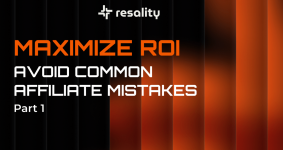Smartlink is a single universal link that automatically matches each user with the most relevant offer. At Resality, we’ve built our own powerful Smartlink solution designed to make launching new campaigns faster and easier. It may sound simple and highly profitable - and it can be - but your results depend heavily on the precision behind your campaign setup. That’s where many media buyers tend to stumble, repeating the same mistakes over and over again. In this article, we’ll look at the most common pitfalls and explain the best ways to prevent them.
Solution: Before launching, always double-check every technical setting, starting with postback. To ensure your tracking works correctly and that you have clean data for analysis, either send your postback link to your affiliate manager so they can configure it, or set it up yourself directly in your dashboard.
Example of a properly set postback link in Resality -
via telegram - https://api.telegram.org/bot7433305463:AAG2lRJ-16U9Bme1t98AgSe-NUsF87u9UxU/sendMessage?chat_id=7173429923&text={{source}},{{country}},{{payout}}
via a tracker - http://trk.smth.com/postback?sub_id={{click_id}}&payout={{payout}}&offer_name={{smartlinkId}}&tid={{slcid}}
Solution: after setting up your postback, always ask your affiliate manager to fire a test conversion. If the test conversion shows up in your tracker without errors, it means the click ID is being transmitted correctly, and you can safely start running traffic.
Examples of correct click_id – cid={{click_id}}, tid={{click_id}}, click_id={{click_id}}
Solution: follow this simple rule: the offer URL always goes to the traffic source, while the postback URL must be placed in the tracker. You’ll find your postback link inside the tracker, along with the correct macro for transmitting click_id. If you’re unsure where to place each link, your affiliate manager can always help.
Example of an offer URL: https://domain.com/client?camp=s9&aff_id=35&source={source}&aff_sub2=banner&click_id={click_id}
Example of a postback URL: https://postback.com/click?cnv_id={{click_id}}&payout={{payout}}
Solution: always use the parameters provided by the network to pass source data to the advertiser. Clearly label your streams - for example source1, source2, etc. These labels can represent different creative approaches, ad platforms, banner types, or test campaigns. The more granular your segmentation, the better your analytics will be, and the stronger the traffic you’ll deliver.
An example of a parameter for transferring traffic sources is &source={source}.
Solution: whenever you connect a new affiliate program or traffic network, always check that all platforms use the same time zone as your main reporting system. This will keep your statistics consistent and prevent confusion.
Example of where to check the time zone in Resality –

Solution: before investing, check reviews of the traffic source - other affiliates have likely tested it already and shared feedback. Don’t go all in from the start: begin with smaller tests, gather results, and only then scale once you see consistent quality.
Examples of reliable traffic networks: ExoClick, TrafficJunky, TrafficFactory
Solution: always ask advertisers for feedback on sources. Once you receive information about bumps or pauses, use that data to build your own lists of effective and ineffective sources. Just remember: each source should generate at least 10–15 conversions to provide enough data for the advertiser to evaluate quality.
Solution: test your pre-landing pages for loading speed and optimize them, especially for mobile devices. Poor mobile performance can kill conversion rates instantly.
Tip: Register with Resality to access pre-landing pages that are already optimized and can be tailored to your campaigns.
Solution: set up auto-rules in your tracker or traffic source before launch. For example, if ROI for a source/segment is below 20% after spending $50/$100/$200, stop it immediately and focus your budget on profitable areas.
Solution: once you’ve chosen the countries you want to work with, double-check their official languages. Adapt all your creatives accordingly. For example, launching in English in Mexico won’t work unless you’ve specifically targeted users with English browser settings. In every other case, your materials should be in Spanish.
Solution: divide campaigns by region or language group - for example, English-speaking and Spanish-speaking - and launch them separately with the right creatives and targeting. You can also adapt the landing page to the browser language. A smartlink is perfect here: it automatically adjusts to the user’s language, device, and other details to show the best offer. But remember, the user still has to go through a properly structured funnel to get there.
Solution: research your audience before launch. This can be done through test campaigns (A/B tests from different angles) or basic independent research. Specialized agencies can also provide surveys with audience insights - like the interests of men 30+, or cultural attitudes toward relationships in Latin America. If you don’t know your audience, you’ll be showing “Find love” while they’re actually searching for “A friend for the evening.”
Solution: EPC, CTR, and CR are the basics of traffic buying - and ignoring them means wasting money. Keep an eye on these metrics to spot weak points and optimize. Don’t hesitate to ask your affiliate manager for EPC tips or request better flows to boost results when using smartlinks.
Solution: every traffic source has its own rules. On TikTok, audio triggers grab attention; in banner ads, strong visuals do the job. Use spy tools tailored to each platform so you can see what’s working and adapt your approach for the channel.
So today we’ve covered some of the most common but fundamental mistakes our partners make when they first start working with us. We hope you found these insights useful. Let us know in the comments if you’d like us to dig deeper into mistakes with creatives - or the missed opportunities that come from not working closely enough with affiliate managers.
Technical mistakes in affiliate program setup
Even with the best creatives and perfectly chosen targeting, technical missteps can completely ruin your performance. Below are the most common weak spots where affiliates often make errors.Common Mistake: postback not configured
Risks: Without postback, conversions are not tracked properly, making it impossible to optimize campaigns or understand real results.Solution: Before launching, always double-check every technical setting, starting with postback. To ensure your tracking works correctly and that you have clean data for analysis, either send your postback link to your affiliate manager so they can configure it, or set it up yourself directly in your dashboard.
Example of a properly set postback link in Resality -
via telegram - https://api.telegram.org/bot7433305463:AAG2lRJ-16U9Bme1t98AgSe-NUsF87u9UxU/sendMessage?chat_id=7173429923&text={{source}},{{country}},{{payout}}
via a tracker - http://trk.smth.com/postback?sub_id={{click_id}}&payout={{payout}}&offer_name={{smartlinkId}}&tid={{slcid}}
Common Mistake: click ID is not transmitted
Risks: when the click ID isn’t passed correctly (or not passed at all), conversions can’t be tied back to the original click. As a result, the data is incomplete, tracking is inaccurate, and campaign optimization becomes nearly impossible.Solution: after setting up your postback, always ask your affiliate manager to fire a test conversion. If the test conversion shows up in your tracker without errors, it means the click ID is being transmitted correctly, and you can safely start running traffic.
Examples of correct click_id – cid={{click_id}}, tid={{click_id}}, click_id={{click_id}}
Common Mistake: mixing up the postback URL and offer URL
Risks: when the offer URL and postback URL are reversed, traffic and data don’t get tracked correctly. As a result, conversions are lost, and budget is wasted.Solution: follow this simple rule: the offer URL always goes to the traffic source, while the postback URL must be placed in the tracker. You’ll find your postback link inside the tracker, along with the correct macro for transmitting click_id. If you’re unsure where to place each link, your affiliate manager can always help.
Example of an offer URL: https://domain.com/client?camp=s9&aff_id=35&source={source}&aff_sub2=banner&click_id={click_id}
Example of a postback URL: https://postback.com/click?cnv_id={{click_id}}&payout={{payout}}
Common Mistake: source parameters (source, subid) are not passed
Risks: without proper source or subid parameters, traffic segmentation becomes impossible. This means that any optimization - payout increases, decreases, or even traffic stops - will apply to all streams equally, leaving no way to keep profitable segments running.Solution: always use the parameters provided by the network to pass source data to the advertiser. Clearly label your streams - for example source1, source2, etc. These labels can represent different creative approaches, ad platforms, banner types, or test campaigns. The more granular your segmentation, the better your analytics will be, and the stronger the traffic you’ll deliver.
An example of a parameter for transferring traffic sources is &source={source}.
Common Mistake: different time zones in the tracker, traffic source, and affiliate dashboard.
Risks: when the time zones don’t match, the data across platforms won’t align. This creates a false impression that conversions are “missing,” while in reality they are just recorded under different time frames.Solution: whenever you connect a new affiliate program or traffic network, always check that all platforms use the same time zone as your main reporting system. This will keep your statistics consistent and prevent confusion.
Example of where to check the time zone in Resality –
Technical errors when launching traffic
At first glance, it all seems straightforward: you have a budget, set up a campaign, check the basics, and start testing. But if you want those test launches to bring real value - both for you as an affiliate and for the advertiser - there are a few mistakes you’ll want to avoid. Let’s go through the most common ones.Common Mistake: choosing a traffic source without verifying its quality
Risks: you may run into a high percentage of bots or incentivized traffic, which ruins both conversion rates and trust.Solution: before investing, check reviews of the traffic source - other affiliates have likely tested it already and shared feedback. Don’t go all in from the start: begin with smaller tests, gather results, and only then scale once you see consistent quality.
Examples of reliable traffic networks: ExoClick, TrafficJunky, TrafficFactory
Common Mistake: no white/blacklists
Risks: without proper whitelists and blacklists, you’ll face poor traffic quality, campaign pauses, and no way to retest strong segments.Solution: always ask advertisers for feedback on sources. Once you receive information about bumps or pauses, use that data to build your own lists of effective and ineffective sources. Just remember: each source should generate at least 10–15 conversions to provide enough data for the advertiser to evaluate quality.
Common Mistake: unoptimized pre-landing page
Risks: slow or unoptimized pre-landers lead to high bounce rates, low engagement, and fewer conversions.Solution: test your pre-landing pages for loading speed and optimize them, especially for mobile devices. Poor mobile performance can kill conversion rates instantly.
Tip: Register with Resality to access pre-landing pages that are already optimized and can be tailored to your campaigns.
Common Mistake: no auto-stop rules for unprofitable sources
Risks: without automation, you’ll keep wasting budget on segments that will never convert.Solution: set up auto-rules in your tracker or traffic source before launch. For example, if ROI for a source/segment is below 20% after spending $50/$100/$200, stop it immediately and focus your budget on profitable areas.
Problems with targeting and strategy
Proper targeting and a balanced strategy are just as important as technical setup. If your ads aren’t reaching the right audience or you ignore the specifics of each traffic source, you won’t see results.Common Mistake: the language of creatives doesn’t match the GEO
Risks: CTR and conversions drop because ads feel irrelevant to users.Solution: once you’ve chosen the countries you want to work with, double-check their official languages. Adapt all your creatives accordingly. For example, launching in English in Mexico won’t work unless you’ve specifically targeted users with English browser settings. In every other case, your materials should be in Spanish.
Common Mistake: running a WW campaign without geo adaptation
Risks: leaving conversions on the table due to lack of personalization.Solution: divide campaigns by region or language group - for example, English-speaking and Spanish-speaking - and launch them separately with the right creatives and targeting. You can also adapt the landing page to the browser language. A smartlink is perfect here: it automatically adjusts to the user’s language, device, and other details to show the best offer. But remember, the user still has to go through a properly structured funnel to get there.
Common Mistake: launching without knowing your target audience
Risks: high CPC and poor ROI.Solution: research your audience before launch. This can be done through test campaigns (A/B tests from different angles) or basic independent research. Specialized agencies can also provide surveys with audience insights - like the interests of men 30+, or cultural attitudes toward relationships in Latin America. If you don’t know your audience, you’ll be showing “Find love” while they’re actually searching for “A friend for the evening.”
Common Mistake: ignoring EPC and CTR
Risks: missing out on potential profit.Solution: EPC, CTR, and CR are the basics of traffic buying - and ignoring them means wasting money. Keep an eye on these metrics to spot weak points and optimize. Don’t hesitate to ask your affiliate manager for EPC tips or request better flows to boost results when using smartlinks.
Common Mistake: using the same approach for different traffic sources
Risks: efficiency drops and campaigns underperform.Solution: every traffic source has its own rules. On TikTok, audio triggers grab attention; in banner ads, strong visuals do the job. Use spy tools tailored to each platform so you can see what’s working and adapt your approach for the channel.
So today we’ve covered some of the most common but fundamental mistakes our partners make when they first start working with us. We hope you found these insights useful. Let us know in the comments if you’d like us to dig deeper into mistakes with creatives - or the missed opportunities that come from not working closely enough with affiliate managers.




